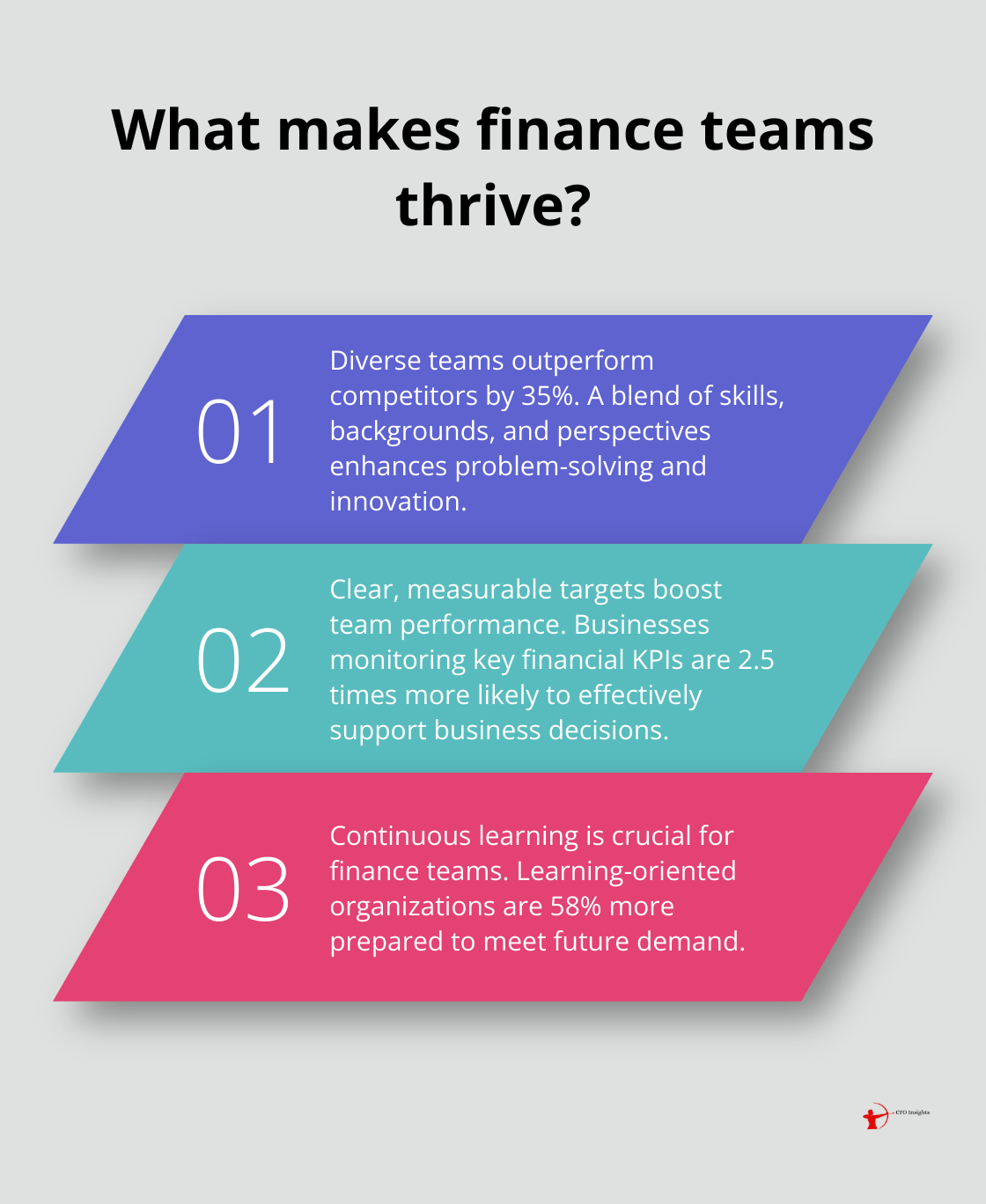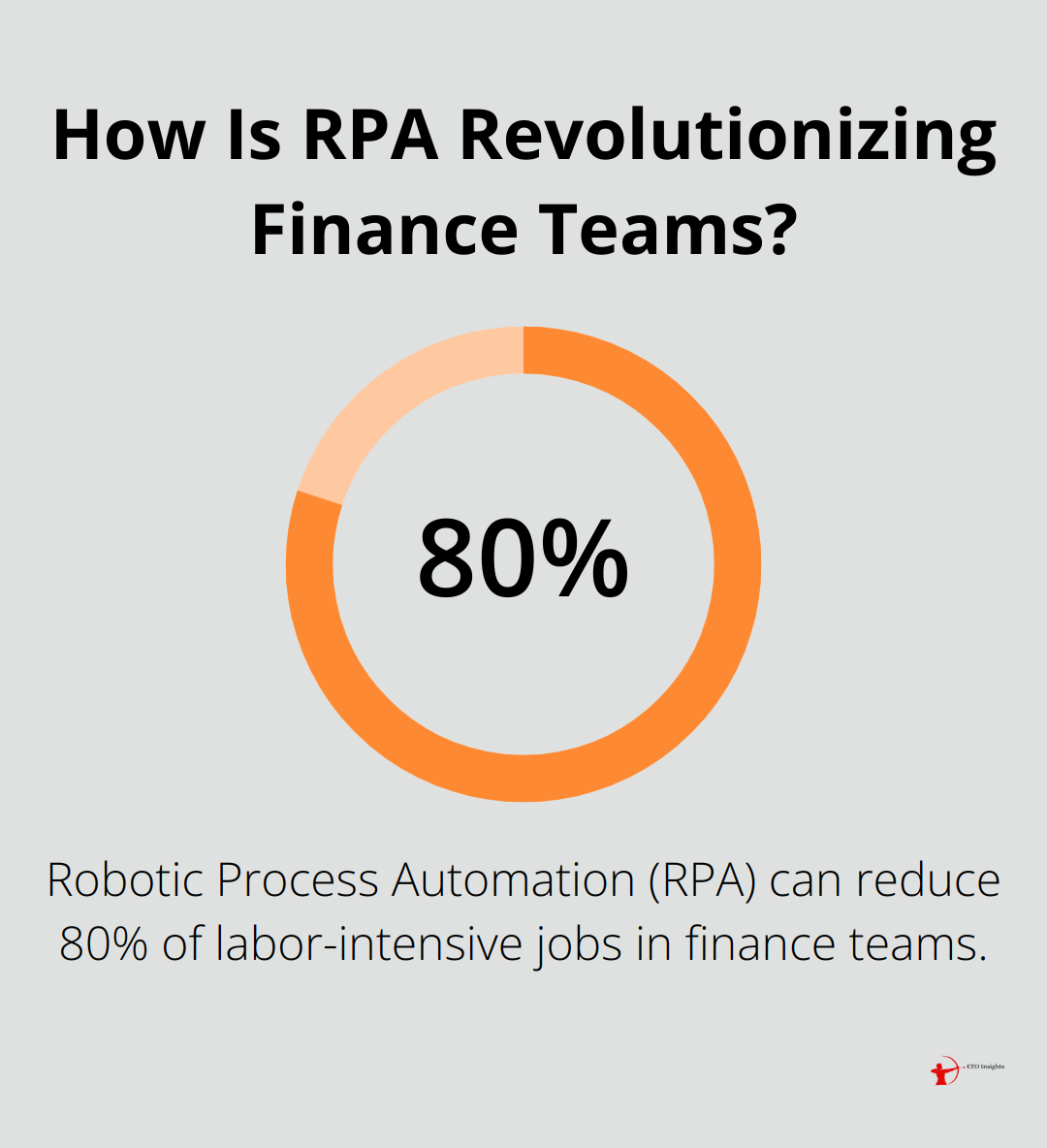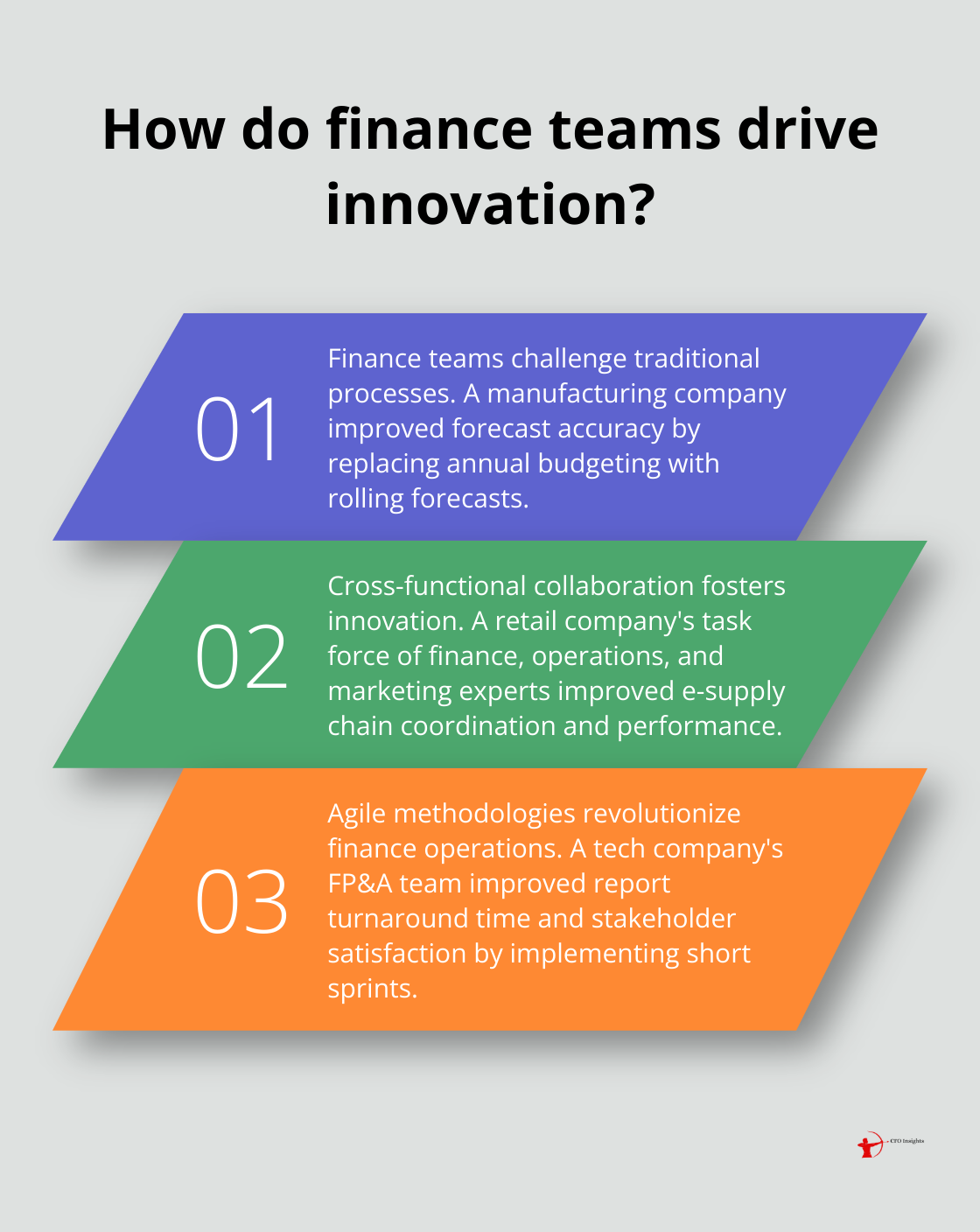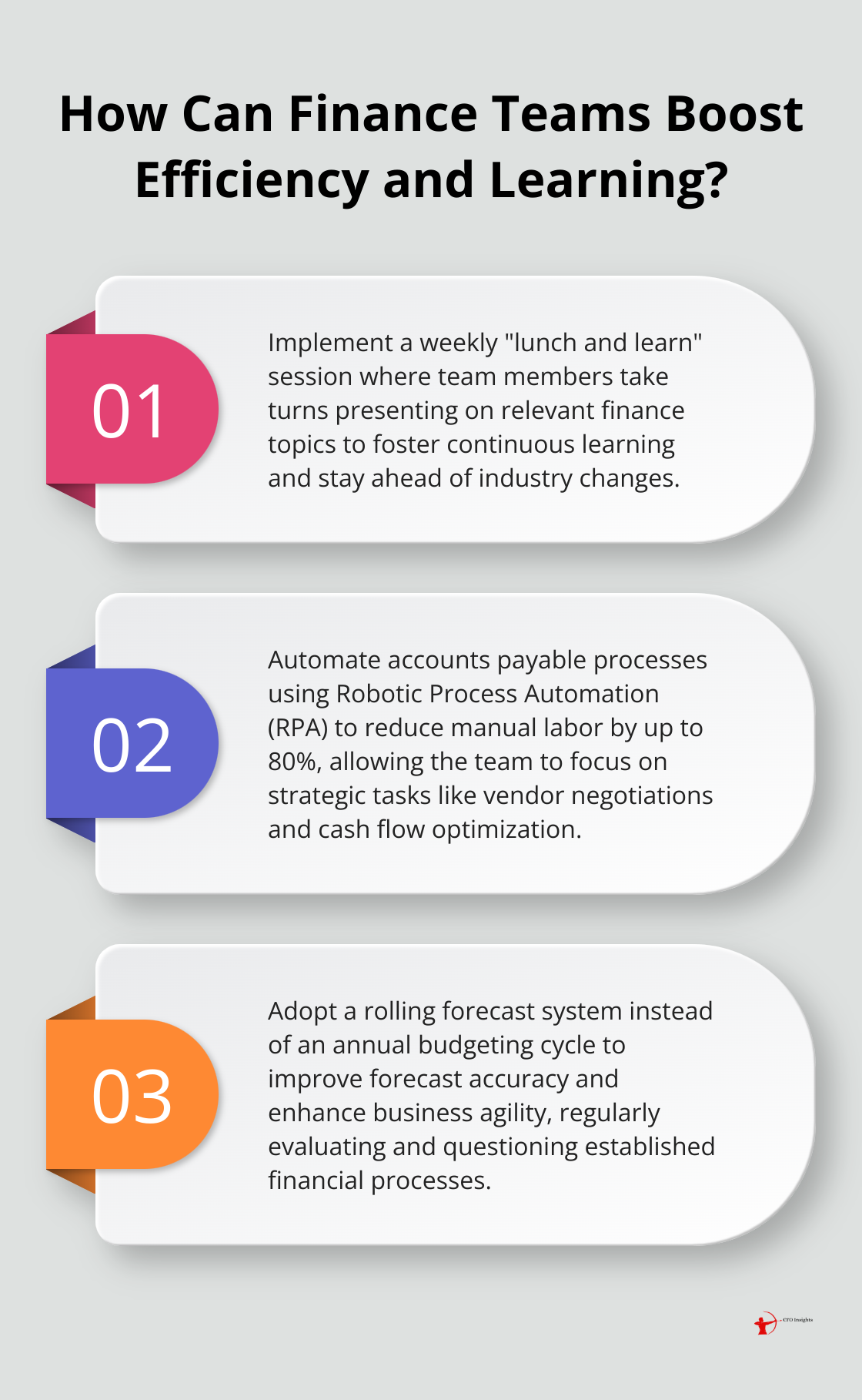High-performance finance teams are the backbone of successful organizations. At CFO Insights, we’ve observed that these teams share common traits that set them apart from the rest.
In this post, we’ll reveal the secrets behind their success, from leveraging cutting-edge technology to fostering a culture of innovation. We’ll also explore how team motivation plays a crucial role in driving excellence and achieving outstanding results.
What Makes Finance Teams Thrive?
Assembling a Powerhouse Team
The foundation of any high-performance finance team is its people. The most successful teams blend diverse skills and backgrounds. A team might include a data analyst who spots trends, a seasoned accountant who knows regulatory compliance, and a strategic thinker who translates numbers into business insights.

Diverse companies are 35% more likely to outperform their competitors. This diversity extends beyond job roles. It brings together people with varied experiences, perspectives, and problem-solving approaches.
Setting Clear, Measurable Targets
High-performance finance teams thrive on clarity. They know their aims and how their work contributes to the bigger picture. We recommend specific, measurable, and time-bound goals for each team member and the team as a whole.
For example, instead of “improve cash flow,” a high-performance team might try to “reduce days sales outstanding (DSO) by 15% within the next quarter.” This specificity makes it easier to track progress and adjust strategies as needed.
A study found that businesses that monitor key financial and operational KPIs are 2.5 times more likely to report high levels of effectiveness in supporting business decisions.
Embracing Continuous Learning
The finance world constantly evolves, and high-performance teams stay ahead through ongoing learning and development. This isn’t just about occasional seminars. It’s about creating a culture where learning becomes part of daily work.
Teams see great results when they set aside time each week for learning activities. This might include sharing insights from industry publications, discussing new regulations, or exploring emerging technologies.
Some teams implement “lunch and learn” sessions (where team members take turns presenting on relevant topics). Others create mentorship programs, pairing junior staff with more experienced colleagues.
The impact of continuous learning is significant. Learning-oriented organizations are 58% more prepared to meet future demand.
These three elements – skilled and diverse talent, clear goals and KPIs, and a commitment to continuous learning – form the core of high-performance finance teams. However, to truly excel, teams must also leverage technology effectively. In the next section, we’ll explore how cutting-edge tools and systems can propel finance teams to new heights of efficiency and strategic impact.
How Technology Supercharges Finance Teams
Automation: The Game-Changer
High-performance finance teams leverage automation to eliminate repetitive tasks. Robotic Process Automation (RPA) can reduce 80% of labor-intensive jobs. This shift allows teams to focus on strategic work that drives business growth.

For example, a company that automates its accounts payable process can expect significant improvements in efficiency and accuracy. This transformation enables the team to prioritize vendor negotiations and cash flow optimization instead of manual invoice processing.
Data Analytics: Turning Numbers into Insights
Data analytics and business intelligence tools revolutionize finance team operations. These powerful platforms transform raw data into actionable insights, enabling faster and more informed decision-making.
Tools like Tableau or Power BI help teams visualize complex financial data, identify trends, and uncover opportunities for cost savings or revenue growth. A mid-sized manufacturing company used data analytics to optimize inventory levels, which resulted in significant cost savings.
Cloud-Based Systems: Real-Time Financial Management
Cloud-based financial management systems provide real-time visibility into financial data, enhance collaboration, and improve security. Companies that adopt these systems often see dramatic improvements in efficiency.
For instance, some businesses reduce their month-end close process significantly by transitioning to cloud-based systems (such as NetSuite or Sage Intacct). The ability to access financial data from anywhere proves invaluable, especially in remote work scenarios.
Moreover, cloud systems facilitate seamless integration with other business tools, creating a more comprehensive view of an organization’s financial health and performance.
Implementation: More Than Just New Software
The adoption of these technologies requires a strategic approach. Proper training and often a shift in team culture are essential for success. However, the payoff is substantial. Finance teams that effectively leverage these tools become true business partners, driving growth and innovation across their organizations.
As we explore the next pillar of high-performance finance teams, we’ll examine how fostering a culture of innovation can further amplify the impact of technological advancements.
How Finance Teams Drive Innovation
Challenging Traditional Processes
Innovation in finance starts with questioning established methods. A manufacturing company redesigned its budgeting process, replacing the annual cycle with a rolling forecast system. This change improved forecast accuracy and enhanced business agility. Finance teams should constantly evaluate their processes to identify areas for improvement.
Fostering Cross-Functional Collaboration
Innovation thrives when different perspectives converge. A retail company formed a task force that combined finance, operations, and marketing expertise. This cross-functional approach uncovered supply chain inefficiencies affecting cash flow. The result? Significant improvements in e-supply chain coordination and performance.
Adopting Agile Methodologies
Agile principles can revolutionize finance operations. A tech company implemented agile methodologies in their financial planning and analysis (FP&A) team. They introduced short sprints for financial reporting and analysis projects. This approach improved report turnaround time and boosted internal stakeholder satisfaction.
Harnessing Advanced Analytics
Forward-thinking finance teams use advanced analytics to uncover deeper insights. A healthcare provider (one of our clients at CFO Insights) used predictive analytics to forecast patient volumes and optimize staffing levels. This data-driven approach not only improved operational efficiency but also enhanced patient care.
Promoting Idea Generation
Creating an innovative culture requires active encouragement of new ideas. Some finance teams implement idea management systems where team members submit and vote on innovative proposals. A manufacturing client saw an increase in cost-saving initiatives after implementing such a system. The key? Create an environment where all ideas are welcome and the best ones are implemented.

Innovation in finance isn’t about reinventing the wheel. It’s about finding new ways to add value to the organization. Finance teams can become true drivers of innovation within their companies by rethinking processes, collaborating across functions, adopting agile methodologies, leveraging advanced analytics, and encouraging idea generation.
Final Thoughts
High-performance finance teams build on skilled, diverse talent, clear goals, and continuous learning. These teams use cutting-edge technology to boost efficiency and strategic impact. They challenge traditional processes and collaborate across functions to drive organizational value. Team motivation fuels the continuous improvement and innovation that distinguishes top-performing finance teams.

Organizations can optimize their finance function with fractional CFO services. At CFO Insights, we offer strategic financial leadership tailored to each organization’s needs. Our fractional CFOs bring experience and best practices to help teams implement strategies and technologies that drive high performance.
Transforming your finance team into a high-performing powerhouse requires commitment and strategy. You can enhance your team’s capabilities, implement new technologies, or foster innovation. Expert guidance often proves invaluable in this journey. Take steps to optimize your finance function and position your entire organization for success in today’s competitive business landscape.
One thought on “Secrets of High-Performance Finance Teams Revealed”
Leave a Reply
You must be logged in to post a comment.





[…] interesting article related to Corporate Strategy is “Secrets of High-Performance Finance Teams Revealed.” This article delves into the key strategies and practices that top finance teams employ to […]